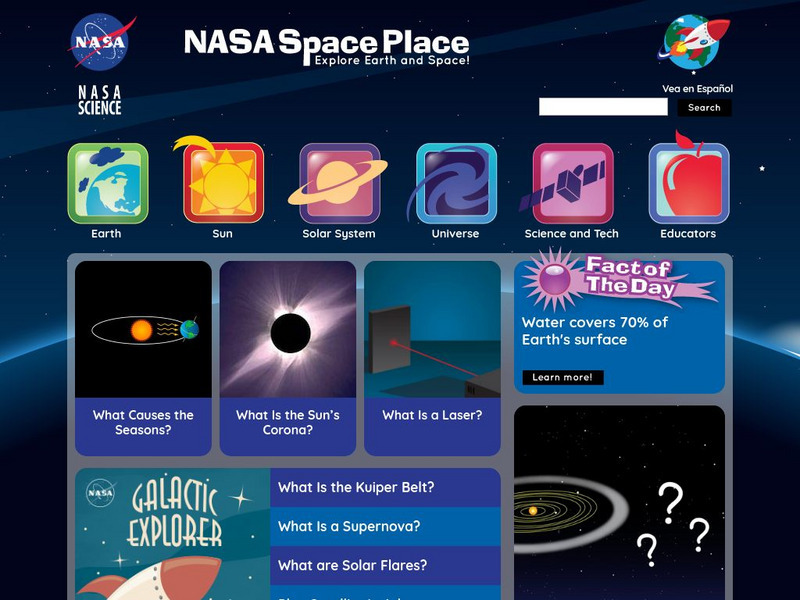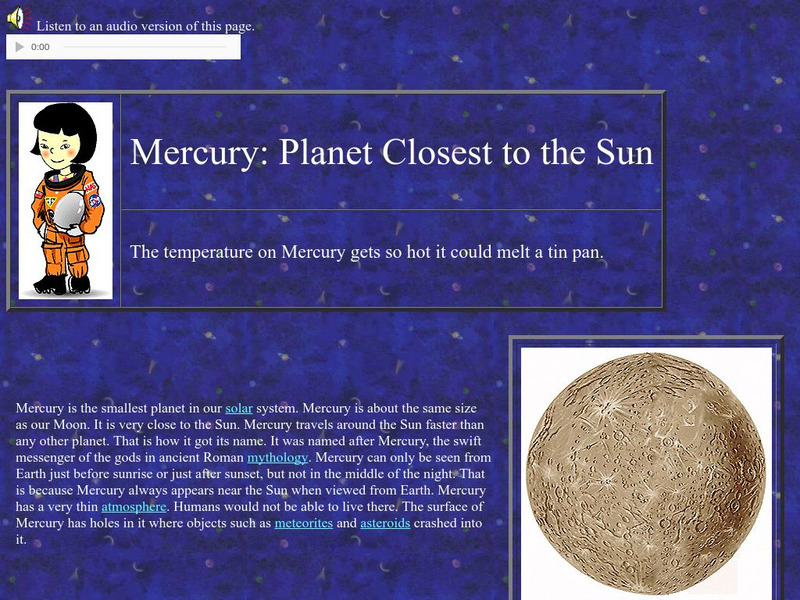ClassFlow
Class Flow: Astronomy and the Solar System
[Free Registration/Login Required] This flipchart presents the layers of the Sun and the components of the solar system.
ClassFlow
Class Flow: Astronomy Planets
[Free Registration/Login Required] The student will be able to compare and contrast the similarities and differences of the planets. The student will be able to name three facts about inner planets and three facts about outer planets.
ClassFlow
Class Flow: Latin the Language of the Solar System
[Free Registration/Login Required] In this lesson students will learn the history of the solar system and how it is associated with the Roman and Greek Gods.
ClassFlow
Class Flow: Learning the Planets
[Free Registration/Login Required] This flipchart includes a matching activity for students to match the planet's names with their pictures.
ClassFlow
Class Flow: Linking You to Our Solar System
[Free Registration/Login Required] Single flipchart page with links to many of the Solar Systems heavenly Bodies. The links allow you to collect Solar system cards from a wonderful website.
NASA
Nasa: The Space Place
This site from NASA's Space Place is geared towards early elementary learners. It offers detailed instructions for crafts and activities related to space, games and a teacher resource area. Students can also ask an expert at this site.
NASA
Nasa Star Child: Planet Hop
Figure out your age and your weight on all the planets in the solar system using the formulas given here. Then type them into the correct place, and let the computer check to see if you are correct.
NASA
Nasa Star Child: Mercury
Provides good information about Mercury and is a good starting point for information about the planet along with pictures and audio. Links to a simple fact table, puzzle, glossary, and more detailed information.
Cornell University
Cornell University: Astronomy: Orbital Motion and Kepler's Laws
At this site from the Astronomy Department of Cornell University, Kepler's three laws of planetary motion are stated. There are brief explanations of each, along with links to additional information on related subjects.
Other
Sandburg Center for Sky Awareness: What Are the Shapes of the Planets' Orbits?
In this lesson plan investigation students learn about the shapes of the planetary orbits by experimenting with ellipses of different proportions.
Other
All (Known) Bodies in Our Solar System Larger Than 200 Miles in Diameter
How big is the Earth compared to the Sun? Is Mars bigger than the Moon? Seeing all bodies in the solar system larger than 200 miles in diameter side by side provides an excellent comparison and an interesting perspective.
Science4Fun
Science4 Fun: Earth
Learn fun facts and details about the geography and composition of Earth, the third closest planet to the sun and the only planet that contains life.
Science4Fun
Science4 Fun: Jupiter
Learn fun facts and details about the weather, composition, and discovery of Jupiter, the largest of all the planets.
Science4Fun
Science4 Fun: Mars
Learn fun facts and details about the weather, geography, composition, and discovery of Mars, the fourth closest planet to the Sun.
Science4Fun
Science4 Fun: Mercury
Learn fun facts and details about the atmosphere, geography, composition, and discovery of Mercury, the closest planet to the sun.
Science4Fun
Science4 Fun: Neptune
Learn fun facts and details about the atmosphere, composition, and discovery of Neptune, the last planet in our solar system.
Science4Fun
Science4 Fun: Pluto
Learn fun facts and details about the atmosphere, geography, composition, and discovery of Pluto, a dwarf planet.
Science4Fun
Science4 Fun: Saturn
Learn fun facts and details about the atmosphere, composition, and discovery of Saturn, the second largest planet.
Science4Fun
Science4 Fun: Uranus
Learn fun facts and details about the atmosphere, composition, and discovery of Uranus, the seventh closest planet to the sun.
Science4Fun
Science4 Fun: Venus
Learn fun facts and details about the atmosphere, geography, composition, and discovery of Venus, the second closest planet to the sun.
University of Texas at Austin
The University of Texas Mc Donald Observatory: Planet Viewing
Guide to the best time to view planets.
Mocomi & Anibrain Digital Technologies
Mocomi: How Big Is the Universe?
Provides facts about the Universe, Jupiter, the Milky Way Galaxy, and Superclusters.
NASA
Nasa Space Place: All About Earth
Brief description of the earth's structure, surface, neighbors, and history with images.














